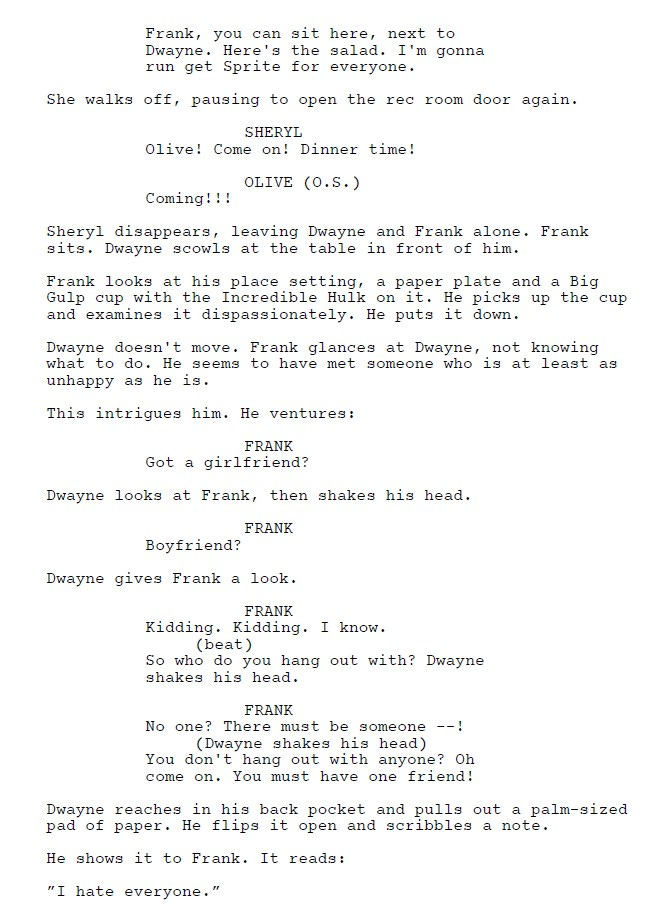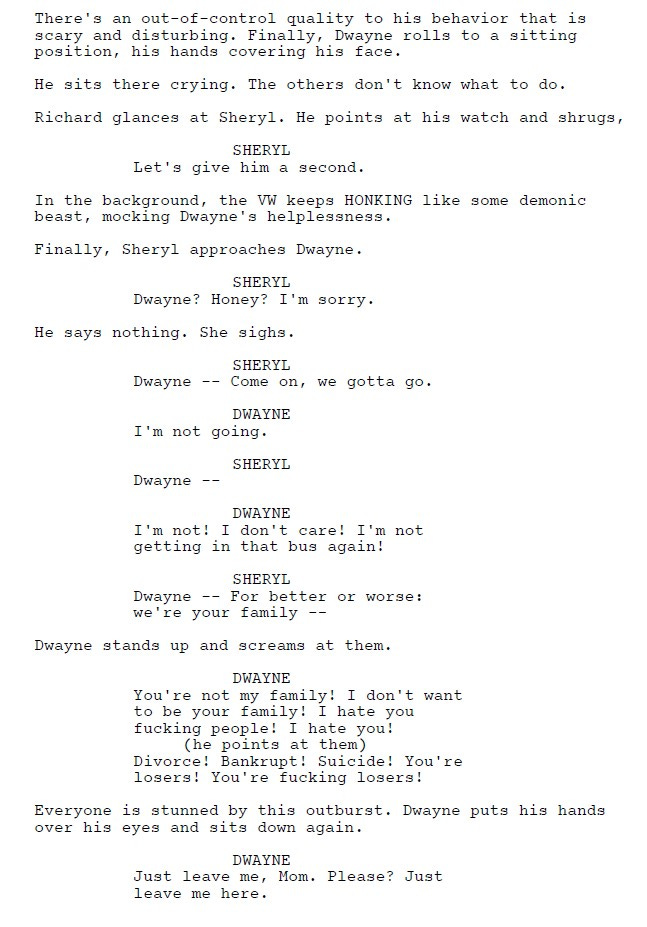Little Miss Sunshine (2006) Script Review | #21 WGA 101 Greatest Scripts of the 21st Century
A heart-warming and humorous tale about a dysfunctional family that catapulted Michael Arndt to success.
Logline: A family determined to get their young daughter into the finals of a beauty pageant take a cross-country trip to California in their old VW bus.
Written by: Michael Arndt
Pages: 114
Scenes: 126
Little Miss Sunshine is both a familiar and refreshing take on the trope of a dysfunctional family on a road trip; it’s got plenty of laughs and empathy, and vividly brings to life all six characters in the screenplay. What more could you ask for?
Meet the Harveys (in the film, they are the Hoovers). A lower middle-class family barely keeping it together, both personally and financially. Richard Harvey is a failing motivational speaker afraid to admit that he’s a loser. Sheryl Harvey, his wife, is the sanest in the family and the one trying to keep everyone together. Dwayne, the eldest child, has taken a vow of silence until he can go to Navy school and fly jets; he also hates everyone. Olive, the youngest, is hopeful and has yet to truly taste the bitterness of the world that has infected most of her family. There’s also Frank, Sheryl’s brother— a recovering suicide patient and gay former Proust scholar. Finally, there’s Grandpa— a cocaine-snorting cranky man (and Richard’s father) who teaches Olive dance routines.
Olive receives an opportunity to participate in the finals of the Little Miss Sunshine children’s beauty pageant after a contestant drops. There’s just one teensy problem: It’s on Sunday, it’s in Florida, and it’s too expensive to take a plane. Left with no choice, they pile into a VW van that is on the brink of falling apart (a not so-subtle symbol of the Harveys’ state) and race to get Olive to the finals in time. A simple yet effective framework that opens the doors for interesting scenes.
For a six-character affair like this, writer Michael Arndt finds a way to pair up characters while also ratcheting tensions between others. Frank is paired with the non-speaking Dwayne, who communicates only via notepad. Grandpa and Olive share a tight bond. Richard and Sheryl have the most scenes together but their marriage is strained due to their circumstances. Meanwhile, Richard and Frank don’t get along, while Dwayne can’t tolerate Richard (it seems that Richard is their stepfather). This also allows different characters to get time for their development.
To set them up, Arndt devotes the first five pages showing each character in their environment they all converge at the dinner table for Scene 17, which runs for 10 pages.
Now while most people would balk at such a long scene, it’s perhaps the most important scene in the screenplay. It shows us the dynamics of the family and ladles out their backstories. It’s not until the end of the scene that they eventually learn that Olive made it into the finals of Little Miss Sunshine. Scene 17, I would argue, is the reason why people want to watch movies. It’s a great way to establish a group of characters early on before diving into the story. Impressively, it doesn’t slow the story down to a crawl; it keeps it moving by filling us in on why Dwayne has taken a vow of silence, why Frank tried to commit suicide, and why Grandpa is living with them. It also shows us why Frank and Dwayne can’t stand Richard.
Act 2, which begins on page 28 and runs for 50 pages, covers the events of their trip. Plenty happens. Richard makes Olive feel momentarily self-conscious about enjoying ice cream if she wants to be a model before the family rallies around her…
The VW van clutch stops functioning, creating tension over whether or not they’ll be able to reach Florida in time; Richard is dealt a blow when he learns that his agent, Stan Grossman, has been ducking his calls because he is unable to sell Richard’s Nine-Step program, something that Richard was counting on to ease the family’s financial issues. Frank is humiliated to run into the student he was once in love with, and is now with his rival. The most shocking moment, however, occurs on page 60, around the Midpoint, when Grandpa dies. This creates a bigger problem: if they stay to make funeral arrangements, they can’t get to the pageant in time. So they steal Grandpa’s corpse and take it with them in the van! There’s a nerve-wracking moment when a Trooper pulls them over for a malfunctioning horn and nearly discovers the body, if he wasn’t distracted by Grandpa’s sex magazines.
But nothing compares to the Low Point and end of Act 2, when Dwayne discovers that his color-blindness will prevent him from getting into flight school, forcing him to break his vow of silence and lash out at everyone in his family.
Act 3 revolves around the Little Miss Sunshine pageant itself and the family slowly overcoming their fractures to work together. Richard and Dwayne worry that Olive will be humiliated against the more professionally-trained contestants; although Richard initially puts pressure on Olive to win, he changes track and confesses to Sheryl in a moment of vulnerability that he doesn’t want Olive to feel like a loser. But Sheryl stands her ground, allowing Olive to decide whether she wants to continue or quit. Olive chooses the former, and we learn that the dance routine Grandpa taught her is a raucous burlesque number! In the script, Arndt makes a note that the choice of song depends on the availability of the rights (though he bravely mentions the Prince song ‘Peach’; in the film, it would be ‘Super Freak’ by Rick James).
Perhaps understandably, the prissy Official is not amused and demands the MC to take Olive off the stage. But that’s when the Harveys step in as a unit. Even though they are in disbelief, Frank is the first to cheer on Olive, followed by Richard, Dwayne, and Sheryl. Richard jumps on stage to stop the MC— and then defiantly starts dancing with Olive; a moment that certainly reminds Sheryl why she married him. In the end, the entire family jumps on stage in solidarity with Olive, leading to the remaining audience giving a standing ovation.
Note: In the finished film, it ends on a punchline—the audience is stunned, and only a grizzled biker jumps to his feet and claps wildly.
For the climax, directors Jonathan Dayton and Valerie Faris told Arndt to create an arc for the characters versus having the situation devolve into anarchy. A wise suggestion. The arc begins namely with Richard—first, he’s hopeful about Olive’s chances; then he’s embarrassed, followed by bewilderment; ultimately, he’s supportive.
Speaking of Richard…
When Arndt sold the script first to Focus Features, they kept trying to turn Little Miss Sunshine into Richard’s story. Arndt vehemently opposed this. He’d written it specifically to be about the family, and didn’t want one character to dominate it just so that the script would attract a big actor. Ultimately, rather than cave in to their demands, he let himself be fired. Another writer was hired to take the story in the direction Arndt refused to take. But fate is a funny thing: Four weeks after he was ousted off the film, the studio head left, and Arndt was rehired! In the end, the only change he did make was to add a scene with Stan Grossman to beef up Richard’s story (small irony- the name is a tribute to the character in Fargo).
Little Miss Sunshine was Arndt’s first screenplay. He wrote the first draft around May 23, 2000, three days after he decided to quit his job working as Matthew Broderick’s assistant, and even broke down those three days of writing:
Day 1- wrote 12 pages;
Day 2- wrote 37 pages;
Day 3- wrote 54 pages in an overnight writing session.
But then, here’s the part that gets glossed over: Arndt spent a whole year rewriting it; he advises aspiring writers to hold back and get all the beats and details before putting it down in a first draft as quickly as possible. He did this in order to use that one year to write a “saleable script.” For despite working as Broderick’s assistant, he had no credits, no agent, and no publishing track record. He’d originally planned to shoot it himself but when the script found its way to Marc Turtletaub, it soon escalated into something else. The script here covers a trip from Maryland to Florida; in the film, budget constraints would change it from New Mexico to California.
Like many first-time writers, Arndt drew on elements from his own life to use in Little Miss Sunshine; namely, the VW bus and the mishaps it endured. The shot clutch, the horn that would not stop honking—they all feel specific, and adds a touch of personality to a script that already feels personal.
Arndt has a highly visual style of writing, especially when it comes to describing things.
He also describes his characters in ways that will give the actor something to work with; and by creating conflict in a natural manner, he is able to develop comedy in organic ways.
One thing worth noting is the unfussy way he solves the challenge of having Dwayne communicate without speaking.
The long journey from page to screen paid off handsomely. Little Miss Sunshine became an indie darling, and won Arndt the Academy Award for Best Original Screenplay— and on his first try, too! It beat out Pan’s Labyrinth, no mean feat; and the success directly led to his writing gig for Toy Story 3— which led to his second Oscar nomination, this time for Best Adapted Screenplay. But the reason it works is because he has created a memorable set of characters, each with their own pains. Everyone wants something, but is also afraid of not getting it. The device of a road trip is used to carefully peel back the layers to show the messiness as well as the bonds that create a family unit. Happy families may all be a like; the Harveys are uniquely dysfunctional yet come together in their own unique way.
Notes:
Myers, Scott (September 3, 2022) | How Michael Arndt wrote “Little Miss Sunshine” (Go Into The Story)
Alloway, Meredith (April 6, 2014) | Oscar winner Michael Arndt talks screenwriting, and offers some advice (The Script Lab)
Guillén, Michael (February 23, 2007) | Michael Arndt, Little Mr. Sunshine (SF 360)
















